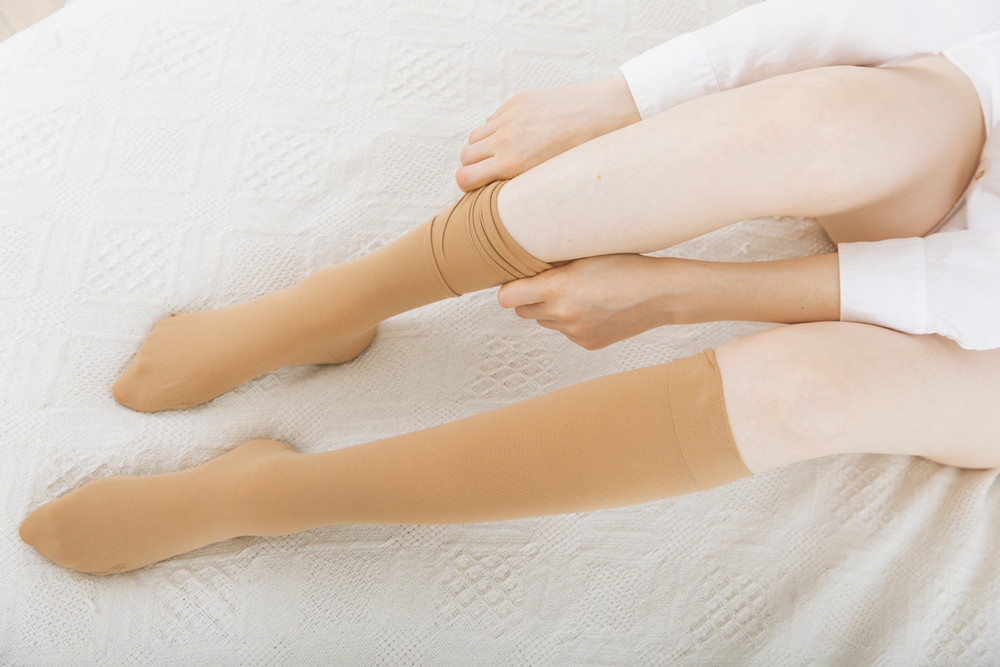Compression socks are used in compression therapy, a non-invasive treatment that helps manage the symptoms of poor blood circulation in the legs. Compression therapy uses snug-fitting socks or stockings to put pressure on the legs to improve blood flow. This is often a recommended first step in managing uncomfortable symptoms such as swelling, heaviness, or cramps.
If you’re considering compression therapy, you may have questions about properly wearing compression socks. Some common questions include:
- How long can compression socks be worn?
- How many hours a day should you wear compression socks?
- Should you sleep in compression socks?
Since wearing the stockings properly will help with the success of your treatment, here is everything you need to know about the why, when, and how of wearing compression socks.
Understanding Compression Socks: What Are They and How Do They Work?
Compression socks are a non-invasive treatment for conditions that cause poor circulation or leg swelling, such as lymphedema, varicose veins, deep vein thrombosis, and skin discoloration around the ankles.
Compression socks use a strong elastic that puts constant pressure on your legs to improve blood flow and move blood back up the leg. The stockings are tight around the feet and ankles, with pressure gradually easing up the leg. The pressure encourages the blood to move back up the leg, preventing it from pooling, decreasing swelling, and relieving feelings of heaviness or pain.
Depending on your needs, the socks are available with different pressure levels. Pressure is measured in millimeters of mercury, or mmHg.
Low pressure (less than 20 mmHg)
Low-compression socks are available over the counter and don’t require a prescription. They are recommended for those who spend a lot of time standing, are pregnant, or are going on a long airplane ride[1].
Medium (20-30 mmHg) to High (over 30 mmHg)
Medium and high compression stockings typically require a prescription. Socks with more pressure should be used under supervision as part of a treatment plan laid out by your doctor.
The type of compression sock you need should be personalized based on your height, weight, and medical needs. If you’re experiencing uncomfortable symptoms related to circulation, such as itchiness, burning, pain, cramping, or heaviness, you may want to speak to your doctor about being fitted for compression socks.
How Many Hours a Day Should You Wear Compression Socks?
Compression socks are meant to be worn for longer periods, so you can wear them all day. However, wearing them during sleep is unnecessary since you’re lying down.
The amount of time you should wear compression socks will depend on why you are wearing them. If you use them to manage a medical condition caused by poor circulation, you should wear them as often as possible or as directed by your doctor.
If you’re wearing them to prevent circulation issues during long periods of sitting or standing, you can remove them once you can move around again.
Keep in mind that the more often you wear your compression socks, the fewer symptoms you will have. If the socks feel extremely uncomfortable, this may not fit properly, so speak to your provider for a better fit.
Can You Wear Compression Socks to Bed?
Yes, it’s safe to wear compression socks to bed, but it is not necessary. When lying down, blood doesn’t pool in your extremities, so you don’t need the pressure from the socks to keep the blood circulating properly.
Some people find that the socks bunch up when lying down, making them tighter. If this happens, it’s okay to remove them for bed unless otherwise directed. Always follow your doctor’s recommendation about how often and when you should wear compression socks.
Recognizing the Signs: When Should You Not Wear Compression Stockings?
Compression therapy has a few contraindications or situations when compression socks should not be worn. If the socks irritate your skin, causing redness, pain, or discomfort, you are likely wearing the wrong size or are wearing them incorrectly. Speak to your doctor, who can help determine if you need a different type of stocking.
Compression socks are not recommended for people with severe peripheral artery disease, peripheral neuropathy, or certain circulation disorders[2]. Your doctor will evaluate your medical history before recommending compression therapy.
Maximizing Comfort: Tips for Wearing Compression Socks Effectively
There are two things to keep in mind to ensure the success of compression therapy and the reduction of your symptoms:
- You have properly fitted compression socks.
- You wear them as often as recommended by your doctor.
The more closely you follow your doctor’s recommendations, the greater success you will have.
Compression socks help symptoms but don’t cure any underlying illness. Other types of treatment may be recommended to improve blood flow more permanently. At Empire Vein & Vascular Specialists, our team is here to help you determine which vein treatment is best for you.
We offer non-invasive procedures, including VenaSeal™, that can treat venous insufficiency, freeing you from having to wear compression stockings and giving you long-term relief.
If you’re suffering from uncomfortable symptoms due to varicose veins, we can help. We have offices throughout Southern California, and we accept most insurance plans.
Contact Empire Vein & Vascular Specialists today to book your free 15-minute consultation and learn more about our treatment options or call 1-800-827-4267.
References:
- Li, R., Chen, Z., Gui, L., Wu, Z., Miao, Y., Gao, Q., Diao, Y., & Li, Y. (2022). Varicose Veins and Risk of Venous Thromboembolic Diseases: A Two-Sample-Based Mendelian Randomization Study. Frontiers in Cardiovascular Medicine, 9, 849027.
- Peripheral Artery Disease. (n.d.). Cleveland Clinic. Retrieved April 1, 2024, from https://my.clevelandclinic.org/health/diseases/17357-peripheral-artery-disease-pad
